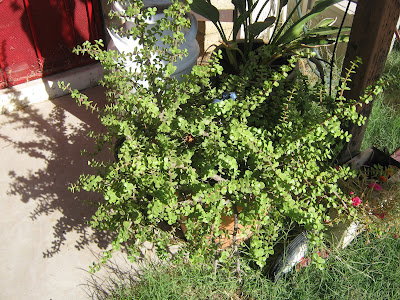It's been a while since I posted any happenings in the garden, so here's a November update. I picked my first home-grown salad of greens and radishes and have continued to pick habaneros and Takanotsumes 2-3 times a week, using some to make homemade hot sauce. I put about a pound of the peppers, minus the caps, in the mini chopper with 2 tablespoons of kosher salt, then placed the mixture in a glass jar to ferment for 12+ hours with the jar lid placed loosely on top. I then added 1 1/2 cups of white vinegar to the mixture and shook it up daily, then loosened the lid; I let this mixture ferment for almost 2 weeks. Finally, I poured the mixture into the mini chopper to blend it, then strained it and put in into jars and refrigerated them. The hot sauce has a pretty good bite to it and I'll definitely be making more.
 |
| Home grown salad with olive oil and balsamic vinegarette. |
 |
| Habaneros and Takanotsumes |
The Eureka lemon has grown to over 7' tall and still has a few lemons ripening on it; they should be ready to pick in January. I found this interesting caterpillar on one of the branches and identified it as a Giant Swallowtail, Papilio cresphontes; it looks a lot like a lizard until you touch it, then it rears up and tries to look menacing.
 |
| A lemon is visible next to the trunk. When ripe, they can weigh over 1/2 lb! |
 |
| Caterpillar of Papilio cresphontes, The Giant Swallowtail |
 |
| Display meant to scare of potential predators. |
The cannas I started from seed are spreading and flowering, I've already saved 5 seeds to share with friends. The salvias that share the bed with the cannas are still blooming and will continue to do so year-round in my zone.
Lastly, I recently received confirmation from the Cornell Lab of Ornithology that I have had a 5th species of dove at my feeders, an African-collared Dove, Streptopelia roseogrisea. I joined Project FeederWatch, run jointly by Cornell Lab of Ornithology and Bird Studies Canada and for a modest $15 fee, they provide the materials needed for the project, as well as newsletters and some basic bird identification charts. I'll be doing my observations of Mondays and Tuesdays and then reporting my sightings on-line; this week I had 10 species during the 2 day observation period. I strongly encourage my readers in the U.S. and Canada to join Project FeederWatch and become citizen scientists.
 |
Africa-collared dove on the left, Eurasian-collared
dove on the right. |
































